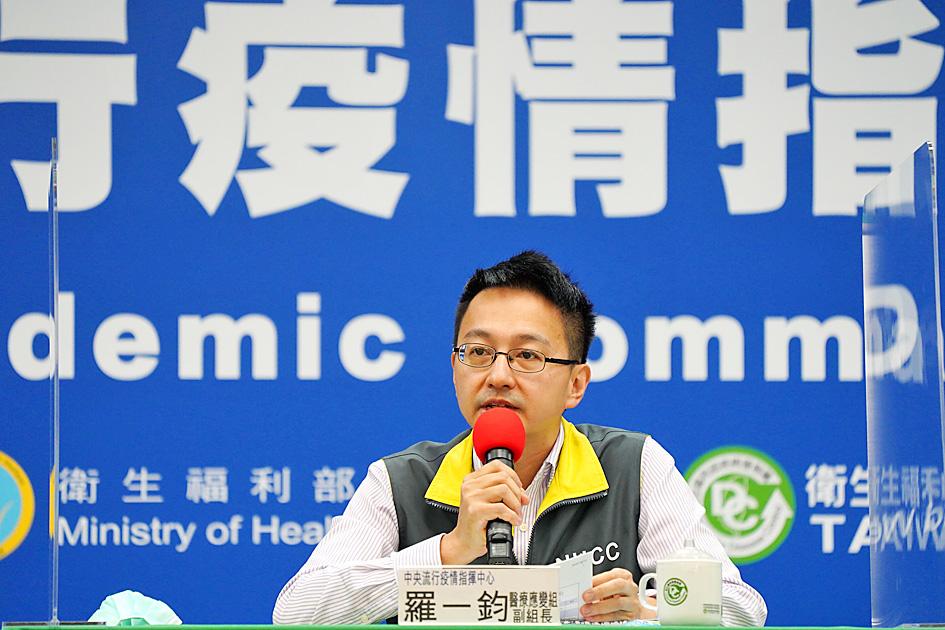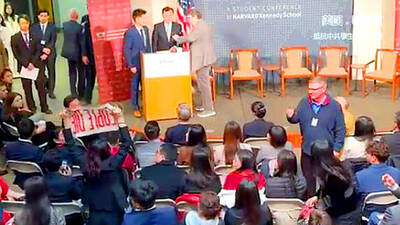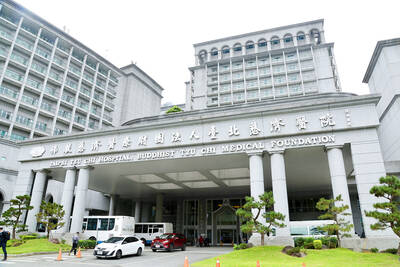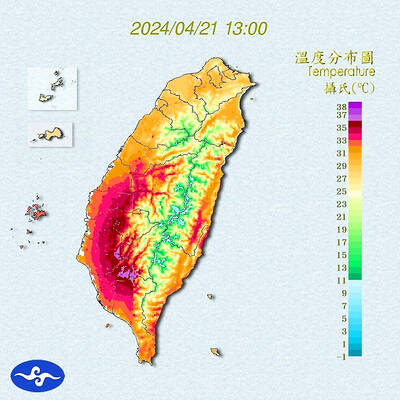The Central Epidemic Command Center (CECC) yesterday reported five imported cases of COVID-19, including a man who tested negative at the airport, but later tested positive during quarantine, as well as three others who tested positive after 14 days of quarantine.
Centers for Disease Control Deputy Director-General Philip Lo (羅一鈞), who is also deputy chief of the CECC’s medical response division, said that the five cases are the nation’s 536th to 540th confirmed cases of COVID-19.
Case No. 536 is a Taiwanese man in his 20s, who works in France and last departed Taiwan in August last year, Lo said.

Photo: CNA
Upon his arrival on Oct. 11, the man told quarantine officers that he had a sore throat two days earlier, so he was tested at the airport, but the result was negative, Lo said.
On Monday and Tuesday last week, the man was coughing, and had diarrhea, fatigue and difficulty breathing during quarantine, but did not report his conditions to the local health department, believing them to be due to allergies and asthma, Lo said.
However, the man was tested again on Friday last week as part of an expanded testing program, and was confirmed positive yesterday, Lo said, adding that six passengers who sat near the man on his flight to Taiwan have been placed under home isolation.
Lo said that a second test was arranged because case No. 530, a Taiwanese man returning from China’s Jiangsu Province, reported by the CECC last week, tested positive at the airport, but not in subsequent tests, nor did his close contacts, so the CECC wanted to clarify the situation.
The expanded testing program was launched to retest 31 cases, whose specimens had been placed in the same machine as No. 530, Lo said.
The two cases were not close contacts and had arrived in different airport terminals at different times, he said, adding that the CECC advisory specialist panel would later address the test results of the expanded program, with a report expected next week.
Case No. 540, confirmed yesterday, is a Russian student in her teens, who tested negative for COVID-19 in another country on Oct. 7, before she arrived in Taiwan on Oct. 9, Lo said.
The student experienced loss of smell on Friday last week and was tested on Saturday, with the result confirmed positive yesterday, Lo said, adding that she had traveled in Turkey for a few days after leaving Russia, so she could have contracted the disease in either country.
Cases No. 537 to No. 539 were all asymptomatic as of yesterday, and they include a Taiwanese man in his 40s who returned from the Philippines, a Filipino man in his 30s who came to work from the Philippines, and an Indonesian student in her teens who came from Indonesia to study in Taiwan, the CECC said.

A group of Taiwanese-American and Tibetan-American students at Harvard University on Saturday disrupted Chinese Ambassador to the US Xie Feng’s (謝鋒) speech at the school, accusing him of being responsible for numerous human rights violations. Four students — two Taiwanese Americans and two from Tibet — held up banners inside a conference hall where Xie was delivering a speech at the opening ceremony of the Harvard Kennedy School China Conference 2024. In a video clip provided by the Coalition of Students Resisting the CCP (Chinese Communist Party), Taiwanese-American Cosette Wu (吳亭樺) and Tibetan-American Tsering Yangchen are seen holding banners that together read:

UNAWARE: Many people sit for long hours every day and eat unhealthy foods, putting them at greater risk of developing one of the ‘three highs,’ an expert said More than 30 percent of adults aged 40 or older who underwent a government-funded health exam were unaware they had at least one of the “three highs” — high blood pressure, high blood lipids or high blood sugar, the Health Promotion Administration (HPA) said yesterday. Among adults aged 40 or older who said they did not have any of the “three highs” before taking the health exam, more than 30 percent were found to have at least one of them, Adult Preventive Health Examination Service data from 2022 showed. People with long-term medical conditions such as hypertension or diabetes usually do not

POLICE INVESTIGATING: A man said he quit his job as a nurse at Taipei Tzu Chi Hospital as he had been ‘disgusted’ by the behavior of his colleagues A man yesterday morning wrote online that he had witnessed nurses taking photographs and touching anesthetized patients inappropriately in Taipei Tzu Chi Hospital’s operating theaters. The man surnamed Huang (黃) wrote on the Professional Technology Temple bulletin board that during his six-month stint as a nurse at the hospital, he had seen nurses taking pictures of patients, including of their private parts, after they were anesthetized. Some nurses had also touched patients inappropriately and children were among those photographed, he said. Huang said this “disgusted” him “so much” that “he felt the need to reveal these unethical acts in the operating theater

Heat advisories were in effect for nine administrative regions yesterday afternoon as warm southwesterly winds pushed temperatures above 38°C in parts of southern Taiwan, the Central Weather Administration (CWA) said. As of 3:30pm yesterday, Tainan’s Yujing District (玉井) had recorded the day’s highest temperature of 39.7°C, though the measurement will not be included in Taiwan’s official heat records since Yujing is an automatic rather than manually operated weather station, the CWA said. Highs recorded in other areas were 38.7°C in Kaohsiung’s Neimen District (內門), 38.2°C in Chiayi City and 38.1°C in Pingtung’s Sandimen Township (三地門), CWA data showed. The spell of scorching